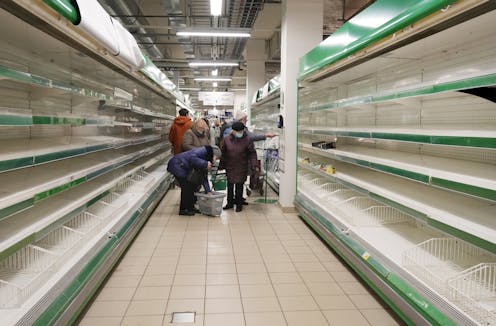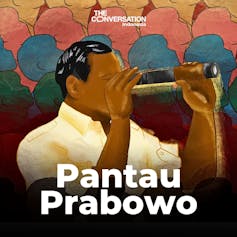Russian ruble's recovery masks disruptive impact of West's sanctions – but it won't make Putin seek peace
- Written by Peter Rutland, Professor of Government, Wesleyan University

Six weeks into the war with Ukraine, Russia’s economy seems to be holding up[1] better than initially expected.
Despite unprecedented sanctions[2] and an exodus of Western companies[3], the Russian ruble – a widely followed indicator of the economy – has recovered all of its earlier losses[4]. Meanwhile, billions of dollars[5] continue to flow in from energy sales to Europe and elsewhere, which has allowed the Kremlin to keep paying its international debts.
However, Russia’s apparently robust financial situation is something of a chimera and masks the real pain being experienced[6] by Russians and stress on the economy.
I’ve been a close observer of Russia for over 30 years[7]. I have been struck by the tension between Russia’s integration into the global economy[8] on the one hand and its growing domestic authoritarianism[9] on the other.
Russia’s integration is what makes the sanctions sting. Its authoritarianism is what makes them irrelevant.
Swift sanctions
Broad and deep sanctions[10] were promptly imposed on Russia by over 50 countries after the Feb. 24, 2022, invasion.
Notably, those joining the sanctions included historically neutral Switzerland – a key location for many of Russia’s overseas banking assets[11] – and Taiwan, the source of 60%[12] of the world’s microchips.
The sanctions had an immediate and dramatic impact. The ruble lost 50%[13] of its value within days as Russians lined up to draw out dollars and rubles from their bank accounts. Panic buying of sugar, buckwheat and other essentials meant empty shelves and scuffles in stores. The official sanctions were followed by a wave of foreign companies[14] deciding to suspend their operations in Russia or pull out entirely.
The ruble recovers
But the more dire predictions of how this would affect Russia have not come to pass.
For example, after plunging to a record low of 136 to the U.S. dollar on March 10, 2022, the ruble has recovered to 83 to the dollar as of April 11, roughly what it was worth[15] before the invasion. This is due to the Russian Central Bank’s imposition of strict rules[16], such as requiring exporters to convert 80% of their dollar earnings into rubles, banning individuals from taking more than US$10,000 out of the country and introducing a 12% tax on dollar purchases.
Likewise, Russia met its debt payments in March, and though the ratings agency S&P declared it to be in “selective default[17]” in April after it paid bondholders in rubles[18] rather than dollars, it still hasn’t fully defaulted on its debt.
While some individual countries such as the U.S., U.K. and Lithuania have announced that they will no longer buy Russian oil and gas, the European Union cannot afford to take such a step until the infrastructure[19] for handling alternative fuel supplies has been created. And China and India continue to be big buyers[20] of Russian oil.
Furthermore, any drop in the volume of sales due to sanctions has been more than compensated by a 60% spike in the price of oil[21].
As a result, Russia continues to rake in $35 billion a month[22] from its oil and gas exports, more than enough[23] to enable it to meet its international debt obligations – and to keep the war going.
Soaring inflation
The ruble, however, is no longer a convertible currency, so its exchange rate is an artificial indicator that tells us little[24] about the economy. Its apparent stabilization is a deceptive measure and doesn’t reflect the traumatic shock that the real economy is experiencing as a result of the sanctions.
The rising cost of living, on the other hand, is a more revealing indicator. It’s something the Kremlin is likely concerned about because it can potentially lead to social unrest[25].
Russian consumer prices rose 7.6%[26] in March and were up 16.7% from a year earlier. Part of this is due to rising global food prices even before the Ukraine war. The United Nations food price index was up[27] 34% in March from a year earlier.
Russian Prime Minister Mikhail Mishustin offered a window into how bad things actually are when he told the State Duma[28] on April 7, 2022, that the crisis is the worst that Russia has faced in 30 years. The economy will take six months to adapt, he added – which may turn out to be an overly optimistic assessment. The European Bank for Reconstruction and Development expects the Russian economy to contract by 10%[29] this year.
Softening the blow on workers
The potential for rising unemployment is another concern.
Analysts surveyed by Bloomberg forecast Russian joblessness[30] to exceed 9% in the coming months, the first time it’s been that high in more than a decade.
To soften the blow, the government is spending 40 billion rubles[31] (about $470 million) subsidizing wages in industries affected by the sanctions. This affects about 400,000 workers in total.
Meanwhile, the fate of the thousands of workers[32] in foreign-owned businesses that are now shuttered remains uncertain. Russia has yet to follow through on threats to nationalize their assets[33], but some companies, such as the local franchisees of retail outlets like McDonald’s, may try to reopen under Russian management and build new brands and supply chains. The Russian subsidiaries of the top Western accounting firms reportedly plan to continue operating[34] under new names.
One important safety valve for Russian workers is the presence of roughly 10 million migrant workers[35], 15% of the total workforce, who are typically the first to be fired. The fall in the remittances[36] they send back home will be a blow to the economies of Central Asia.
Tech troubles
Russian consumers and companies are also encountering shortages of a wide range of goods, including pharmaceutical supplies[38], such as asthma inhalers, and drugs for Parkinson’s disease. Even copy paper, whose price has tripled[39] over the past month, is hard to come by because of a halt to the import of key chemicals, leading to calls[40] for university entrance exams to be suspended this year.
[Like what you’ve read? Want more? Sign up for The Conversation’s daily newsletter[41].]
The situation looks particularly grave in the information technology sector. Russian companies and state-owned enterprises remain heavily dependent on imported hardware and software – despite a 2017 order[42] to wean themselves off of Western software. As part of the sanctions, companies like Microsoft and Google are no longer doing business[43] in Russia, leaving local managers scrambling to find alternative software.
Compounding the problem is the fact that tens of thousands of IT professionals are leaving Russia[44] because they can easily work overseas, free from the economic and political restrictions of life in Russia. In a bid to stem the flow, on March 29, 2022, Prime Minister Mishustin signed a decree[45] exempting IT professionals from the draft.
A bleak future
The goal of the Western powers in imposing sanctions was to increase pressure on the government in the hope that President Vladimir Putin would come to the realization that the costs of continuing the war in Ukraine exceed the benefits. Unfortunately, that strategy may exaggerate the extent to which Putin factors the living standards of ordinary Russians into his decision-making calculus.
Moreover, the war and the resulting sanctions seem likely to be further empowering hard-line nationalist elements of the Russian government, with some critics calling for a reintroduction of Soviet-style central planning and a military mobilization[46] of the economy.
Put simply, the future looks bleak for Russian citizens, who will continue to bear the brunt of the sanctions. Putin apparently expects them to tighten their belts until he achieves his “victory” – which is increasingly being seen in Russia[47] as a war with the “collective West,” not just Ukraine.
References
- ^ seems to be holding up (fortune.com)
- ^ unprecedented sanctions (theconversation.com)
- ^ exodus of Western companies (theconversation.com)
- ^ has recovered all of its earlier losses (www.themoscowtimes.com)
- ^ billions of dollars (www.reuters.com)
- ^ the real pain being experienced (theconversation.com)
- ^ over 30 years (www.wesleyan.edu)
- ^ integration into the global economy (www.ponarseurasia.org)
- ^ authoritarianism (www.amazon.com)
- ^ sanctions (www.piie.com)
- ^ many of Russia’s overseas banking assets (www.bloomberg.com)
- ^ source of 60% (www.kommersant.ru)
- ^ ruble lost 50% (theconversation.com)
- ^ foreign companies (som.yale.edu)
- ^ what it was worth (www.xe.com)
- ^ strict rules (www.wsj.com)
- ^ selective default (www.ft.com)
- ^ it paid bondholders in rubles (www.nytimes.com)
- ^ until the infrastructure (econtribute.de)
- ^ continue to be big buyers (theprint.in)
- ^ 60% spike in the price of oil (www.ft.com)
- ^ $35 billion a month (www.business-gazeta.ru)
- ^ more than enough (ridl.io)
- ^ tells us little (www.nber.org)
- ^ because it can potentially lead to social unrest (www.doi.org)
- ^ Russian consumer prices rose 7.6% (www.themoscowtimes.com)
- ^ United Nations food price index was up (www.ft.com)
- ^ told the State Duma (www.kommersant.ru)
- ^ contract by 10% (www.wsj.com)
- ^ forecast Russian joblessness (www.bloomberg.com)
- ^ is spending 40 billion rubles (ria.ru)
- ^ thousands of workers (www.bloomberg.com)
- ^ threats to nationalize their assets (www.reuters.com)
- ^ reportedly plan to continue operating (www.ft.com)
- ^ roughly 10 million migrant workers (www.reuters.com)
- ^ fall in the remittances (www.rferl.org)
- ^ Alexei Nikolsky, Sputnik, Kremlin Pool Photo via AP (newsroom.ap.org)
- ^ pharmaceutical supplies (www.kommersant.ru)
- ^ price has tripled (ria.ru)
- ^ leading to calls (ria.ru)
- ^ Sign up for The Conversation’s daily newsletter (memberservices.theconversation.com)
- ^ despite a 2017 order (www.kommersant.ru)
- ^ no longer doing business (www.washingtonpost.com)
- ^ are leaving Russia (www.themoscowtimes.com)
- ^ signed a decree (www.themoscowtimes.com)
- ^ military mobilization (topwar.ru)
- ^ seen in Russia (globalaffairs.ru)
Authors: Peter Rutland, Professor of Government, Wesleyan University


